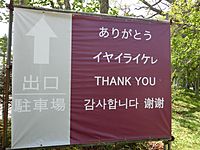Ainu language facts for kids
Quick facts for kids Ainu |
||||
|---|---|---|---|---|
| アイヌ・イタㇰ Aynu=itak | ||||

|
||||
| Native to | Japan | |||
| Region | Hokkaido | |||
| Ethnicity | 15,000 Ainu people in Japan (no date) | |||
| Native speakers | 10 (2007) | |||
| Language family | ||||
| Writing system | Katakana, Latin | |||

The historically-attested range of the Ainu (solid red) and the suspected former range (pink) based on toponymic evidence (red dots) [Vovin 1993], Matagi villages (purple dots), and Japanese isoglosses
|
||||
|
||||
The Ainu language is spoken by the Ainu people, who live in northern Japan. For a long time, Ainu was only a spoken language. It wasn't written down until the 1800s. Today, it can be written using either katakana (a Japanese writing system) or the Latin alphabet (like English).
Contents
Where Ainu Was Spoken
In the 1800s, the Ainu language was spoken in a much larger area. This included Hokkaidō Island and the southern part of the Chishima Islands (also known as the Kuril Islands). It was also spoken in the southern part of Sakhalin.
Today, Ainu is mostly spoken only on Hokkaidō Island. Sadly, very few people speak Ainu now.
Ainu Dialects
The Ainu language used to have many different dialects. These included Chitose, Saru, and Karapto. These dialects were quite different from each other. Someone speaking one dialect might not understand someone speaking another.
Today, only the Hokkaidō dialect of Ainu is still spoken.
How Ainu is Different
Ainu is a language isolate. This means it is not clearly related to any other language family in the world. It's like a unique language all on its own!
Historically, Ainu speakers lived near people who spoke Japanese and Itelmen. Itelmen is a language from the Kamchatka Peninsula. The Nivkh language, spoken in northern Sakhalin, is another language that is also an isolate.
Ainu Grammar Basics
Ainu has a special word order, like Japanese. Sentences usually follow a "subject-object-verb" pattern. This means the person or thing doing the action comes first. Then comes the thing the action is done to, and finally the action itself.
For example, in English we say "I eat apples" (Subject-Verb-Object). In Ainu, it would be more like "I apples eat."
Interesting Ainu Words
The word ainu means "human being" in the Ainu language. It's the name the Ainu people use for themselves.
Another important word is kamuy, which means "god" or "spirit." The Ainu people believe that everything in the world that has a mind and plays a role is a kamuy. This includes sparrows, trees, and even natural forces. The Ainu believe that humans and kamuy should help each other. This helps everything go well and brings happiness to people.
Most language experts think that the Ainu way of counting is based on groups of twenty.
| number | Ainu (in Saru dialect) | Nivkh | Japanese |
|---|---|---|---|
| 1 | siné | ñaqř | hi |
| 2 | tu | meqř | hu |
| 3 | re | ţaqř | mi |
| 4 | íne | nəkř | yo |
| 5 | asíkne | t‘oqř | itsu |
| 6 | iwán | mu | |
| 7 | árwan | na | |
| 8 | tupésan | ya | |
| 9 | sinépesan | ko | |
| 10 | wan | mxoqř | tō |
Here are some other interesting Ainu words:
- Ape - fire
- Iyomante - A special festival to send a bear's soul to the spirit world
- Kunnechupu - The moon
- Kotan - village
- Konru - ice
- Sumari - (pronounced like "Shumari") - fox
- Seta - dog
- Tonoto - sake (a type of alcoholic drink)
- Nonno- flower
- Huci - (pronounced like "Hoochi") - grandmother or an old woman
- Pone - bone
- Pirka - Beautiful or cute
- Wakka - "drinkable" water
Images for kids
-
Pirka Kotan Museum, an Ainu language and cultural center in Sapporo (Jozankei area)


